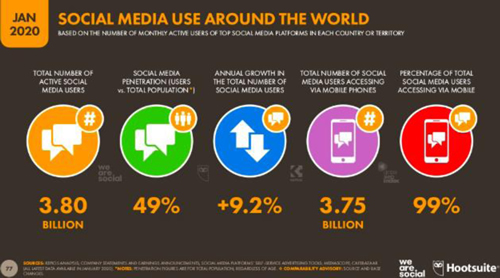
doi.org/10.15178/va.2022.155.e1410
RESEARCH
ADVERTISING USE OF INSTAGRAM BY SPANISH MODELS BEFORE THE AEA AND AUTOCONTROL CODE OF CONDUCT
USO PUBLICITARIO DE INSTAGRAM POR PARTE DE MODELOS ESPAÑOLES ANTES DEL CÓDIGO DE CONDUCTA DE AEA AND AUTOCONTROL
USO PUBLICITÁRIO DO INSTAGRAM POR MODELOS ESPANHÓIS ANTES DO CÓDIGO DE CONDUTA DE AEA E AUTOCONTROLE
Jesús Segarra-Saavedra1
Dalía Carratalá-Martínez1
Alejandra Romero-Coves1
1University of Alicante. Spain
ABSTRACT
Influence marketing has become a essential tool for companies in general and especially for those that work in the fashion area. This article investigates, through the exploratory analysis of content, the presence on social networks and the content of the posts published in Instagram by the twenty most influential Spanish male and female fashion models according to Models.com. The advertising use and its engagement is studied. The results allow us to contrast the advertising strategy carried out by these influencers with respect to the recent Spanish Association of advertising and Autocontrol code of conduct (2020).
KEYWORDS: Influencer, Instagram, influence marketing, fashion, non conventional advertising, advertising and fashion, social networks, social media marketing
RESUMEN
El marketing de influencia se ha convertido en una herramienta fundamental para las empresas en general y especialmente para las del sector de la moda. Se investiga, a través del análisis de contenido exploratorio, la presencia en redes sociales y el contenido de los posts publicados en Instagram por los veinte modelos masculinos y femeninos españoles de moda más influyentes según Models.com. Se estudia el uso publicitario y su engagement. Los resultados permiten contrastar la estrategia publicitaria llevada a cabo por estos referentes influenciadores con respecto al reciente Código de conducta de la Asociación Española de Anunciantes y Autocontrol (2020).
PALABRAS CLAVE: Influencer, Instagram, marketing de influencia, moda, publicidad no convencional, publicidad y moda, redes sociales, social media marketing
RESUMO
O digital influencer tem se tornado uma ferramenta fundamental para as empresas em geral e principalmente para o setor de moda. É investigada, por meio de análise exploratória de conteúdo, a presença nas redes sociais e o conteúdo das postagens publicadas no Instagram pelos vinte modelos de moda masculina e feminina espanholas mais influentes segundo a Models.com. Se estuda o uso publicitário e o engagement. Os resultados permitem contrastar a estratégia publicitária desenvolvida por estes influencers comparado com o recente Código de Conduta da Associação Espanhola de Anunciantes e Autocontrol (2020).
PALAVRAS-CHAVE: Influencer, Instagram, marketing de influencer, moda, publicidade não convencional, publicidade e moda, mídia social, marketing em mídia social
Correspondence
Jesús Segarra-Saavedra. University of Alicante. Spain jesus.segarra@ua.es
Dalía Carratalá-Martínez. University of Alicante. Spain liacarratala@gmail.com
Alejandra Romero-Coves. University of Alicante. Spain alejandraromerocoves@gmail.com
Received: 22/10/2021
Accepted: 02/12/2021
Published: 03/01/2022
How to cite the article
Segarra-Saavedra, J., Carratalá-Martínez, D., and Romero-Coves, A. (2022). Advertising use of Instagram by Spanish models before the AEA and autocontrol code of conduct. Vivat Academia. Revista de Comunicación, 155, 1-25. http://doi.org/10.15178/va.2022.155.e1410
Translation by Paula González (Universidad Católica Andrés Bello, Venezuela)
1. INTRODUCTION
The emergence of new technologies drastically changed the classic schemes of communication and the form of interaction between users. With the creation of social networks and digital platforms, users were allowed to share content created by themselves, facilitated the interconnection between equals, and eliminated barriers and schemes allowing two-way communication.
According to the IAB Annual Study of Social networks (2019), more than 25.5 million people use social networks, of which 85% are aged between 16-65 years. Instagram is the social network that increases in the number of users, as well as one of the key supports for the appearance of the well-known influencers.
In fashion, the figure of the prescriber and now influencer has evolved. During the 80s, the figure of the professional in the fashion or model sector resurfaced as a mass marketing tool. Fashion brands chose to use global beauty standards in their advertising campaigns as the perfect showcase to project the new creations of the designers of the time. Young models achieved with their image that the brand became closer and more desirable to the public. However, with the emergence of social networks, numerous studies (Padilla and Oliver, 2018; Pérez and Luque Ortiz, 2018) have concluded that, currently, the most well-known fashion influencers at the national level are people without studies in the industry that started by sharing non-specialized content.
1.1. Communication in the fashion sector and the use of social networks
Social networks are the digital platforms that attract the most audience since they present the most accessible, personalized, and economical way for the user to share information about products or services (Adán, 2016, p. 13).
According to Adán (2016, p. 24), their main characteristics are:
Social networks have improved the quality of life of many people and with this, companies have benefited. It has allowed the customer to connect with the company in a simpler and faster way, besides improving internal and external relationships so that customer retention is much more effective.
According to Sánchez and Pintado (2010, p. 46), there are many advantages that companies that use them have:
According to Mediakix (2019), social networks have grown at a dizzying rate in the 21st century. Since 2012, registered users in at least one social network have grown and there is no indication that the number is decreasing. It is estimated that users spend an average of 2 hours on social networks every day and it has been concluded that brands are increasingly using them as an essential marketing technique for their campaigns.
Source: We Are Social (2020)

Chart 1. Social networks with active accounts globally
According to this report, around 3,800 million people around the world are active in social networks and more than 3,750 million connect through a mobile device. It is confirmed that the number of active users in social networks has grown by 7% compared to 2019. More and more users decide to create an account on these platforms.
Source: We Are Social (2020)
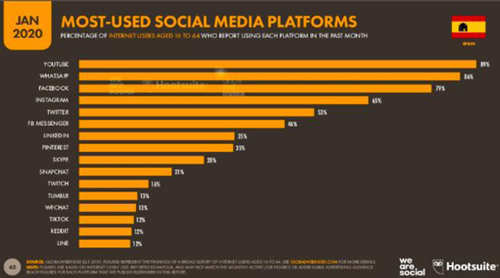
Chart 2. Social networks with active accounts in Spain
However, in Spain, 62% of the total population are active social network users who spend around 1h 51 minutes a day using them from any device. The most widely used platforms nationwide are YouTube, WhatsApp, Facebook, Instagram, and Twitter.
1.2. Instagram
Instagram has become a key tool in today's communication landscape. According to IAB Spain (2019), it is the third most used network daily, besides being the one that increases the most in users each year, its frequency of visits increases.
Mediakix (2019) states that 89% of marketers say that Instagram is one of the most effective channels in brand marketing strategies. With this, this social network is consolidated as the most popular influencer marketing channel in 2019.
Furthermore, Instagram is a channel that facilitates the relationship of brands with users. According to SEO Consultant (2014), it also allows:
1.3. The influencer as a marketing tool
Social networks have allowed the figure of the prescriber to have more power of influence. Currently, it is an effective technique for brands that intend to influence the public, specifically in their purchase decision, but also in the image they perceive of them, among other objectives. With the rise of social networks, the recommendation of products has been extended, expanding the techniques to interact with users and establish a connection with them.
Continuing with the figure of the prescriber analyzed by Castelló and Pino (2015), it is essential to mention that since the 1930s, famous people were already used to influence the public. A vital parameter that brands saw in the figure of the advertising prescriber was to show a credible relationship between product and celebrity, when this happened, an influence was established on the target audience. They also establish that another very important parameter in the relationship is trust.
In the era of socialization of audiences (Aguado, 2015, p. 110), trust is binding and a fundamental value that must be borne in mind and, therefore, the importance of that term in brand management. When prescribers gain the trust of the user, they can influence the decision-making of individuals. They, as stated by Baena (2011), help to form aspirational groups, that is, the groups to which we, in turn, would like to belong for one reason or another (aspirational group).
For Armano (2011), the influence of the prescriber is based on six pillars: scope, proximity, experience, relevance, credibility, and trust. Castelló and Pino (2015) affirm that the old advertising prescriber and the influencer of the 21st century turn out to be the same figure, simply with technological advances and a globalized world thanks to the Internet, endowed with an unusual power that both marketing and advertising have shown. Among the prescriber's capabilities is trendsetting, ranging from generating social awareness, to a mere commercial interest in wanting to increase sales of a product.
This practice has given rise to the so-called influencer marketing, in which social networks are merged as advertising spaces with the resource of users, such as opinion leaders or famous people, such as prescribers or influencers, to whom brands direct their communication efforts to reach more potential consumers through them (Castelló-Martínez, 2016, p. 27).
The landscape of communication platforms changes rapidly and marketing strategies must be updated to attract the target audience. One of the preferences of social network marketing is the study of influencers. Its effectiveness has made it an indispensable asset for marketers (Mediakix, 2019).
Pedrayes (2018) indicates that an influencer is a person with a great presence in social networks and strong credibility due to their knowledge in a certain sector and/or topic. They interact with followers constantly so that they feel supported, and with it, establish a strong affective bond.
According to Nocito, de Moya, Gutiérrez, and López (2017) “Currently, it is thought that influencer marketing is the new revolution in global advertising. For the forward-thinking salesperson, increasing influence on social networks represents a world of opportunities” (p. 11).
Castelló and Pino (2015) propose a classification. First of all, celebrities are people whose success is based on their popularity in society. Second, opinion leaders are those who are experts on a specific topic and share specific content related to the topic in question. To the two previous types of prescribers, the figure of the blogger is added, someone with knowledge about their field of action, access to social networks, and that provides alternative material that helps the brand. Finally, prosumers are the consumer who produces and shares content about the product. This type can be considered an influencer or not depending on their scope level. They share their opinion about a product without the need for the brand to have hired them.
Castelló and Pino (2015) study influencer marketing in the current communication landscape as a collaborative strategy by companies and influencers in a certain sector to achieve a beneficial objective in the public. With them, favorable content for companies is generated, be it a massive campaign, a blog post, or a publication in social networks. But, in this case, it is worth remembering the five types of influencers that exist. Castelló and Pino (2015) state that companies must create an influencers map that addresses the main users of interest for the brand. The problem that the prescribers generate is their level of credibility, many of them have been affected for creating content in which it is clearly visualized that they are not personally interested and that they have simply shown it because the brand has paid them for it.
On the other hand, according to the Augure Report on the status of influencer marketing (2017), influencers have the ability to generate a domino effect, that is, it makes thousands of people start following them in a matter of seconds, either for a photo on Instagram or a post on Facebook, for example. They have generated a large community in which they share their opinions and assessments of products or services on the market, generating a virtual empire made up of users from all over the world.
Source: Augure Launchmetrics (2017)
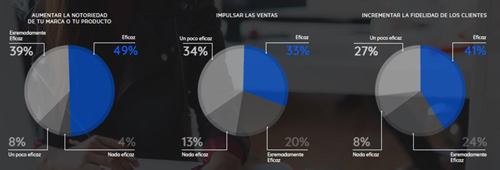
Chart 3. Influencer Marketing Effectiveness in 2017
According to the chart, influencer marketing remains a key strategy if you want to increase brand or product awareness. Instead, driving sales or increasing loyalty are becoming key objectives in strategies with influencers. According to the results of the report, in 2017, 88% of professionals stated that this type of technique was very effective, 65% said it was also effective in improving customer loyalty, and more than 50% said it was effective for boosting sales.
They also stated that the key scenarios to maintain a collaboration with influencers are: product launch (35%), events (33%), corporate ads (25%), and content promotion (7%). For its part, Zaremba (2014) highlights the main benefits for the brand: recommendation power, influence in strategic circles, and alternative access to large audiences.
Some cases of influencer marketing, according to Antevenio (2019), at an international level is that of the Wish brand in 2018. The e-commerce company launched a campaign under the hashtag #timeonyourhands to promote itself. For this, it used several relevant soccer stars such as Gareth Bale, Neymar Jnr, or Paul Pogba, to publish a post on Instagram. And one of the best-known cases according to Medium (2019) is Nespresso and actor George Clooney.
Castelló and Pino (2015) conclude that it is evident that in the world of communication and advertising, social networks take a special role and generate new efficient techniques for brands. Influencer marketing has made it possible to reach a large number of followers, segmenting them and creating a link to establish a conversation to influence the public.
However, to create a strong bond with the public, the influencer's communication strategy must be subject to current legislation. As stated by Anunciantes y Autocontrol (2020), following the research by Segarra-Saavedra and Hidalgo-Marí (2018), among others, advertising collaborations must be identifiable for followers using the generic indications and codes that result from application.
1.4. Communication in the fashion sector
For Torregrosa, Noguera, Sánchez, and Del Río (2014) fashion is a relevant but complex research object. For Codina and Herrero (2004), it is a polyhedral reality that is related to three elements: anthropological, economic, and cultural dimension. Anthropological because it is a reality that is born and is supported by nature in the body and soul of the person. Economic because it offers the possibility of selling clothes where creativity and innovation are favorable tools. Finally, cultural because is understood as a trend followed by society. Therefore, there is a tendency for companies to communicate intangible values associated with a life project (Saviolo and Testa, 2007).
Business communication in the field of fashion is a key element in the management of the organization. For Rius (2006), in fashion communication, the right target audience is sought and strategies are used to show added values such as lifestyle, known designers, or an image that provides status.
According to Villena Alarcón (2013), the language of fashion has a great impact on communication because it is aspirational through models and celebrities. However, fashion uses a mix of tools to look at the needs of the public, from advertising to public relations. However, the sector has evolved with the birth of Prêt à porter (ready to wear), fashion not manufactured in series and available in stores in different sizes (Vanitatis, 2018).
With the rise of new technologies, communication has been helped by various tools to facilitate connection with the target audience. García Orosa (2005) stated that the communication department must take into account the New Information Technologies and take advantage of their effectiveness. Most companies have incorporated the Internet into their business strategy and for this reason, online stores have had a positive reception.
For Cantoni (2003), technological advances bring numerous advantages to firms such as expansion capacity, virtual catalogs, e-commerce, and, therefore, improve relationships with their audiences. However, the web will have a better chance of success if it works as a reinforcement to the usual physical store. Villena Alarcón (2013) coincided with Cantoni, seeing in new technologies the possibility of internationalization to virtually enter foreign markets, contributing to the expansion of the brand image and products, improving relations with the public.
According to Del Olmo (2005, p. 233) influencing the public can be done from fashion shows or showrooms or the media, among others. When selecting the medium, all the information to be transmitted must be taken into account, how long the message will last, and the type of channel used. Each company has characteristics depending on the country in which it lives and the coverage of the medium. Depending on each case, the company can work with unconventional or conventional means.
Regarding external communication, Villena Alarcón (2013) affirms that the audiences to which the fashion company addresses are intermediaries, suppliers, clients, prescribers, etc. Among its most used instruments, they can be obtained according to their relationship with the media and the rest of the public: call and press conference, press releases, press dossiers, fashion shows and fairs, conferences, catalogs, corporate magazines, or showrooms. From the point of view of society, other activities are sponsorship and patronage.
However, Gil Mártil (2009, p. 61) also saw the presence of prescribers in fashion trends as appropriate due to their ability to influence the public, classifying them as opinion leaders, fashionistas, trendsetters, and celebrities. Martínez and Vázquez (2008, p. 87) classify fashionistas as all photographers, models, designers, hairdressers, stylists, and fashion editors. However, coolhunting are those that acquire the true leadership, in charge of identifying innovations or inspirational trends in new collections (Gil Mártil, 2009, p. 20). Within fashionistas, designers have been acquiring a leading role in fashion, representing the firm of the brand for which they work and the communicative subject through the Dircom. Nevertheless, Martínez and Vázquez (2008, p. 84) affirm that the names of designers themselves have served to create a concept known by the public, creating a communication image.
On the other hand, trendsetters and celebrities are people capable of setting trends or fashion, so firms often use them to be the image of the brand, either as guests at events or advertising campaigns (Gil Mártil, 2009, p .65).
In short, as stated by Gil Mártil (2009), the media and advertising act as social legitimizers and, in the fashion sector, they are the most used for the dissemination and promotion of brands. However, with the rise of social networks, they see on the Internet a new opportunity for expansion in their market. The field of fashion is aware of the influence that its communication agents have on the behavior of the public and, therefore, they resort to them to show the new trends in the fashion industry.
According to Sanz-Marcos and Pérez-Curiel (2019, p. 5), fashion is in a process of reinforcing and activating digital alliances, therefore, technology has made brands promote themselves and see a great opportunity in social networks to offer the best visual, creative, and eye-catching content for the user.
The celebration of the Academy Awards Gala or the film festivals of Cannes, Venice, Toronto, or Berlin have transcended the cinematographic information and have occupied covers and reports starring not only the most internationally popular actresses and actors but also the firms who have dressed them for the occasion and the brands that have named their accessories (Segarra-Saavedra and Hidalgo-Marí, 2017, p. 315).
According to Villena Alarcón (2013), Spanish fashion companies use, besides influencers, other characteristic tools of communication in this sector: fashion websites, Online Visual Merchandising, newsletters, and virtual press, among others. Undoubtedly, the Internet has favored the proliferation of virtual press offices from where communication professionals can access the specific information of the firm, providing speed and interaction (Castillo, 2006).
In conclusion, Villena Alarcón (2013) assures that the Internet has improved the communication of Spanish fashion companies, building a much more stable company-product and client connection. Society, thanks to the boom in communication, has integrated brands into its life and with it, its products and creative messages. However, companies must continue to maintain that constant conversation with their target audience to remain attractive to customers through different strategies and direct and indirect channels.
2. OBJECTIVES AND HYPOTHESIS
2.1. General objective
To comparatively analyze the use of influencer marketing on Instagram through the main Spanish male and female models and contrast if their posts, published in 2020, would comply with the ethical standards of the Code of Conduct of the Spanish Association of Advertisers (AEA by its acronym in Spanish) and Autocontrol that entered into force on January 1st, 2021.
2.2. Specific objectives
2.3. Hypothesis
3. METHODOLOGY
This comparative study of influencer marketing on Instagram through the figure of the main Spanish male and female models is proposed as an exploratory study and for this, it is carried out through content analysis.
In the first place, a study of the communication channels most used by the models is established, as well as identifying their social networks, level of popularity, and the number of interactions reached. Their social networks are approached based on quantitative criteria (number of followers, publications, and likes). Second, the study focuses on the profiles of the models on Instagram, as it is one of the networks most used by users daily (IAB Spain, 2019). The sample corresponds to the top 20 most popular and sought-after male and female models in Spain according to the Fashion Models website.
The 165 posts published by these twenty models on Instagram during the week of February 1st to 15th, 2020 are analyzed, given that during this period several events closely related to fashion took place: the Academy Awards gala and Mercedes Benz Fashion Week, as well as Valentine's Day, relevant to the advertising and fashion sectors, which often make use of it from a marketing point of view.
With this content analysis, the profiles of Spanish models on Instagram, their formal characteristics and post formats, presence on Instagram, and elements used from the advertising point of view are studied.
Table 1. Phases of the research

Source: own elaboration
4. RESULTS
According to models.com and taking into account the selection variables (rankings, social, women/men, Instagram), the top ten most relevant and popular Spanish models are:
Table 2. Models and position in the ranking
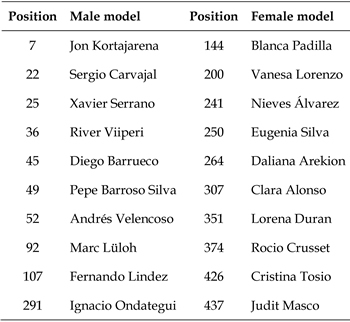
Source: own elaboration
If we compare the positions, it is observed that male models are in higher positions than female models. Jon Kortajarena is the most relevant model (position 7) and Blanca Padilla is the best positioned relevant female model (position 144).
From the study of their social networks, it is clear that not all the models use the same social networks. 6 of the 20 have a website or blog. All of them are women, so this tool does not predominate among the analyzed models. On Facebook, 50% of these models have a profile.
Pinterest is not a prominent network among these 20 models since only 5% have a profile on that social network. YouTube also does not stand out among the analyzed models since only 30% have a channel. Against this, it stands out that 80% have a profile on Twitter, being this social network, followed by Instagram, the ones that predominate. All the models have a profile on Instagram, this being the predominant social network in the sample of models and, therefore, also the main channel analyzed in this study. Faced with this data, none have an account on LinkedIn.
On Instagram, 165 posts distributed by models are identified and analyzed:
Table 3. Posts on Instagram
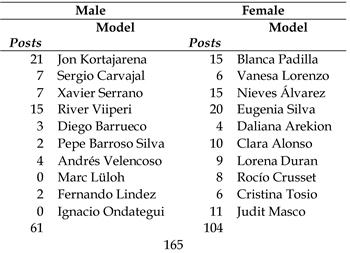
Source: own elaboration
Of the 165 publications, only 61 correspond to male models compared to 104 female models. Therefore, female models spread 63% of the posts compared to 37% of the male models. It is observed that the predominant day is Saturdays, compared to Wednesdays, when they publish less content.
Table 4. Day of the week
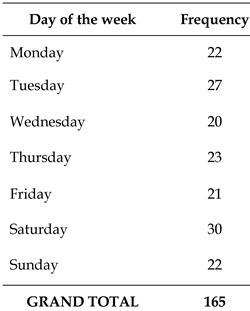
Source: own elaboration
100% of the posts are self-produced, that is, they do not repost posts from other users like brands. The most relevant data is that none of the posts identifies their nature as advertising, sponsored post, product placement, or other labels alluding to advertising intent, such as those subsequently advised by the AEA and Autocontrol (2020): "advertising", "ad", “in collaboration with”, “sponsored by”, “[Brand] Ambassador”, “Thanks to [brand]”, “Gift from [Brand]”, “Sponsored trip".
Taking into account the user tagging, there are tags in 121 posts (73%), distributed among 83 in female models and only 3 in male models.
42% of the publications include the geolocation of the post and 93% do not refer to commercial geolocation. Therefore, it is shown that on rare occasions the models refer to commercial places.
In 91% of the posts, the influencer appears. The majority presence is alone:
Table 5. Form of the presence of models in their posts

Source: own elaboration
Only 2 posts are identified as advertising. In both cases, it is carried out by the same model, Rocío Crusset, and both cases are paid collaborations, as can be seen:
Source: https://bit.ly/3scIT0p and https://bit.ly/3sjxQT9

Image 1. Posts with paid collaborations by Samsung Spain published by Rocío Crusset
91% of the models include text in their posts compared to 9% who do not even include emojis.
Table 6. Most used words in models
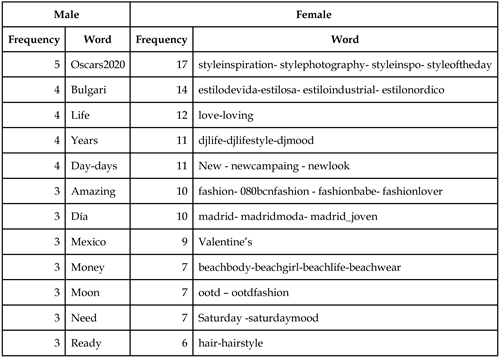
Source: Word cloud (https://bit.ly/2YHrVuy)
The most repeated word by the models is Oscars2020 - coinciding with the fact that during the study period (from February 1st to 15th) the Oscars 2020 took place, specifically on February 10th, 2020 - followed by the Bulgari brand, in charge of the clothing of the models for various events. Regarding the rest of the words, the models usually upload content of the days in which they have attended a place or have enjoyed the event and thank brands or photographers for trusting them, that is why the references "day-days", "amazing", “día”, or "thank".
In female models, the most used words have to do with fashion content with hashtags such as "styleinspiration", "estilosa", or "newlook". Besides, most of the words are related to the events that took place during the period such as Madrid Fashion Week, the Oscars, or Valentine's Day.
In both genders, the predominant language is English with 65%, followed by Spanish with 23%.
Source: own elaboration
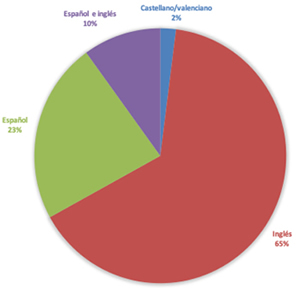
Chart 4. Language of the publications
In 153 publications (93%), no question addressed to the followers appears. The average number of questions they usually include is 1, so their posts do not invite the participation of followers. In 93 publications, there is no presence of hashtags. And in the case of emojis, 22% do not use them compared to 78% who usually include them in the text. The average number of emojis is 3 and a total of 326 is counted.
Source: own elaboration
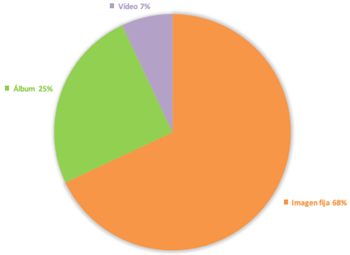
Chart 5. Image format
113 posts (68%) are still images. 25% are photo albums that include an average of 3 photos per album for a total of 114 images. There are only 14 posts in video format, of which 9 appear with the brand mentioned in the music or sound.
In 115 posts (70%) an advertising brand visually appears, on the other hand, in 50 publications (30%) it does not. Of these 115 publications, the economic sector that predominates in male models, if the brands that appear visually in the posts are taken into account, is “Distribution and Restoration”. In female models "Textile and Clothing" and "Beauty & hygiene" predominate, closely linked to fashion.
Table 7. Visual markings on models

Source: own elaboration.
Regarding the presence of advertising brands in videos, the “Beauty & hygiene” sector predominates in female models, however, in male models, there are no brands in their videos.
In 53% of the posts, no brand is cited. The rest are distributed as follows:
Table 8. Sectors most cited by models
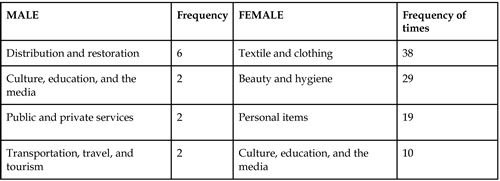
Source: own elaboration
In 121 posts (73%) brands are tagged, among which the sectors "Textile and Clothing", "Beauty & hygiene", and "Personal objects" predominate”.
Table 9. Comparison of brands tagged by models
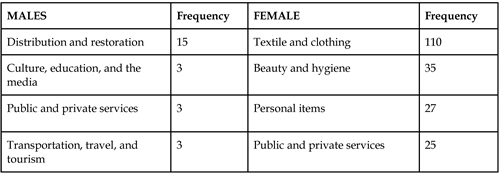
Source: own elaboration
72% of the posts do not use self-tagging, that is, among their tags, they do not include that of their user. No post contains a hyperlink, since they only work in bios.
From the study of the interaction of the posts, these general features are identified:
Most of the posts of female models have the objective of "Promotion" with a total of 51 publications, however, male models have the purpose of "Other", with 31 publications, related to their personal life, individual photoshoots, or personal projects, leaving aside the advertising factor.
Tabla 10. Comparison of the objective of the posts of models
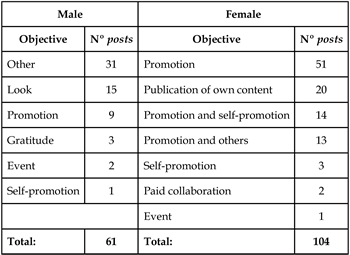
Source: own elaboration
5. CONCLUSIONS
After the results obtained from the comparative study, these conclusions can be drawn, which revolve around the hypotheses raised.
We are, therefore, facing repeated and constant advertising practices carried out not only by models but also by influencers (Segarra-Saavedra and Hidalgo-Marí, 2018), football players (2020), and a long list of professionals, who should adhere to this code, apply it, and comply with it rigorously to not repeat the comparative grievances to which media such as television and the Internet are subjected, from an advertising point of view. New research opportunities are opening up that invite us to analyze the companies and brands (commercial and personal) that adhere, as well as the degree of compliance.
REFERENCES
AUTHOR/S
Jesús Segarra-Saavedra
Professor of the Department of Communication and Social Psychology at the Universidad de Alicante. Postdoctoral researcher in the groups "Comunicación y públicos específicos" (COMPUBES) of the UA and “Comunicación y Sociedad Digital” (COYSODI) of UNIR.
Orcid ID: https://orcid.org/0000-0001-9420-5258 Google Scholar: https://bit.ly/3dI5hsa Researchgate: https://publons.com/researcher/2195125/jesus-segarra-saavedra/
Dalía Carratalá-Martínez
Graduated in Advertising and Public Relations at the Universidad de Alicante. Certified in the Fundamentals of Digital Marketing course from Google Activate. Currently, a clerk at the Citees company.
Orcid ID: https://orcid.org/0000-0001-5885-1906 Google Scholar: https://scholar.google.com/citations?user=PnB-bJEAAAAJ&hl=es
Researchgate: https://publons.com/researcher/4848772/dalia-carratala/
Alejandra Romero-Coves
Graduated in Advertising and Public Relations at the Universidad de Alicante. Community Manager at Valentina (La Tienda de Valentina).
Orcid ID: https://orcid.org/0000-0001-7643-2051 Google Scholar:https://shorturl.at/ikK03 Researchgate: https://publons.com/researcher/4845554/alejandra-romero-coves/